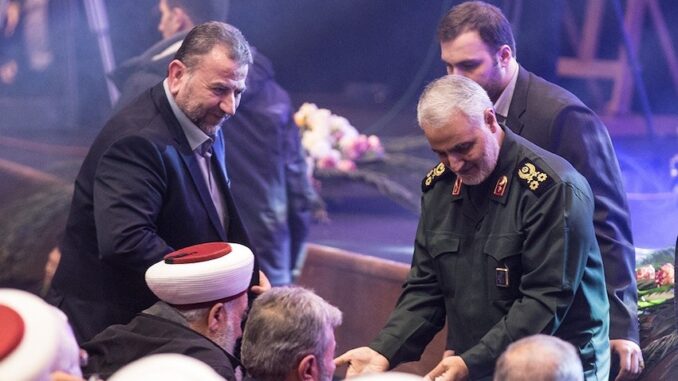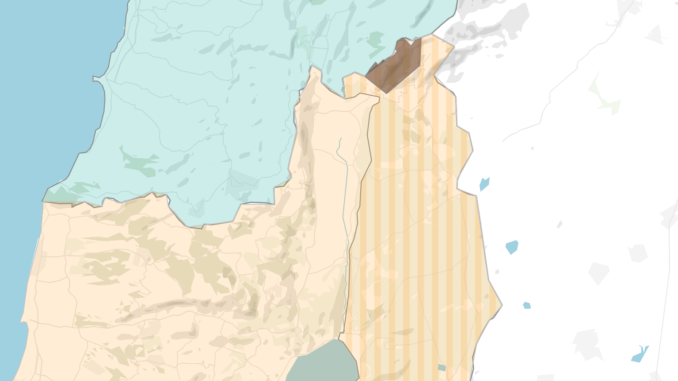By A Correspondent on the Ground, AMWAJ.MEDIA 2 Jan 2024

Senior Hamas commander Saleh Al-Arouri and former Iranian Quds Force commander Qasem Soleimani at a commemoration ceremony in Tehran, Iran on Jan. 16, 2018. (Photo via Fars News Agency)
A suspected Israeli drone strike has killed senior Hamas military commander Saleh Al-Arouri in southern Beirut. The rare precision attack targeted an office of the Palestinian movement in Dahiyeh, a suburb known as home to many supporters of the Iran-backed Hezbollah movement. Given the choice of target as well as the location and timing, the incident is seen as a major escalation by Israel, which is mired in bloody fighting in Gaza.
The assassination of Arouri, who for the past six years was deputy political bureau chief of Hamas, has significant dimensions in the context of the Gaza war and the regional confrontations it has sparked. Importantly, the killing also puts the spotlight on the triangle of relations between Hamas, Hezbollah, and Iran’s Quds Force—and what may be next.
Hits on high-value targets
The assassination of Arouri comes barely a week after the killing in Damascus of Iran’s most influential military commander in the Levant. Seyed Radhi Mousavi was assassinated in a suspected Israeli airstrike in the suburb of Sayyidah Zainab. Informed observers view the killing of Mousavi as on par with the US killing of former Quds Force commander Qasem Soleimani and Israel’s targeting of late Hezbollah military chief Imad Mughniyeh.
Of further note, Arouri was hit on the eve of the fourth anniversary of Soleimani’s killing, and ahead of a speech by Hezbollah leader Hassan Nasrallah marking the occasion.
The recent assassinations in Beirut and Damascus have a common denominator: Israel’s possible intention to eliminate commanders working with what is known as the Joint Operations Chamber of the Iran-led ‘Axis of Resistance’. In this vein, Tel Aviv could be sending a message to Tehran that it is capable of targeting any person—no matter how senior—who has a say in the coordination among Iran-backed groups in the region.
To grasp the dynamics at play, it is essential to understand the role of Arouri. It is well known that the late senior Hamas commander was in charge of the Palestinian movement’s operations in the West Bank. What is less known is that he was also responsible for maintaining relations and coordination between Hamas and Hezbollah on one hand, and Hamas and Iran on the other.
In his role as coordinator, Arouri developed special relationships with both Nasrallah and Saeed Azadi, the Quds Force commander in charge of the Iranian elite unit’s Palestinian dossier. In the aftermath of the killings of Arouri and Mousavi, informed sources in the region privately speculate, Azadi may be Israel’s next target given his prominent role in building and reinforcing the infrastructure of the ‘Axis of Resistance’ in the Levant, including Palestine.
Evolution of an ally
Speaking on condition of anonymity, an informed source close to Hamas told Amwaj.media, “For Hamas, Arouri was in the middle ground among the group’s active wings. He enjoyed special ties with those in the Gaza Strip and the West Bank, namely [Gaza chief] Yahya Sinwar and [top military commander] Mohammed Deif.” The source further described Arouri as also having had strong ties with the Palestinian movement’s leaders in Qatar and Turkey, ”specifically” politburo chief Ismail Haniyeh and the latter’s predecessor Khaled Meshaal.
”While Arouri was mostly in perfect harmony with Sinwar and Deif, he was also not at odds with Haniyeh and Meshaal,” the source explained, “He was a highly diplomatic and moderate figure when handling issues relating to internal disputes within Hamas.”Preferring that his name be withheld given the sensitivity of the matter, an informed source close to Hezbollah explained the evolution of Arouri into a close partner of both the Lebanese movement as well as Iran.
According to the source, Arouri initially “had a deep dispute with Hezbollah” when he arrived in Lebanon some years ago, after being expelled from Turkey under reportedly strong Israeli and US pressure. The tension is said to have gone back to events in Syria after the eruption of Arab Spring protests in 2011. As the Syrian government cracked down on a violent uprising with the help of Iran and Russia, Hamas refused to side with President Bashar Al-Assad—leading to a major rift with Damascus and Tehran. Arouri was among Hamas officials who left Syria for Turkey, although their stay in Istanbul did not last long.
“In the years that followed [the rift with Hamas], Nasrallah managed to absorb Arouri which turned the latter into a power card within Hamas but in Nasrallah’s hand,” the informed source close to Hezbollah alleged to Amwaj.media, “Some even say that Arouri was a [pro-]Hezbollah hawk within Hamas. This goes to say a lot about the kind relationship Arouri had with Nasrallah, and their almost weekly communication.” A source close to Hamas echoed this characterization of Arouri’s views and stances.
Contentious Frontiers
 The Israel-Lebanon-Syria borders have long been contested. Israel occupied the Golan Heights in 1967 (orange stripes) and annexed the territory in1981. The Shebaa Farms (dark brown) were captured by Israel in 1967 when they were considered Syrian territory. In 2000, Lebanon (green)—backed by Syria—claimed the Shebaa Farms.
The Israel-Lebanon-Syria borders have long been contested. Israel occupied the Golan Heights in 1967 (orange stripes) and annexed the territory in1981. The Shebaa Farms (dark brown) were captured by Israel in 1967 when they were considered Syrian territory. In 2000, Lebanon (green)—backed by Syria—claimed the Shebaa Farms.
Speaking on condition of anonymity, a regional observer in the know also described Arouri as having been pushed into Iran’s arms due to changing regional circumstances. “Interestingly, he had a very negative view of Iran, but when he was asked by Turkey to leave its territory…he came to know the Iranians closer.” Describing the late senior Hamas commander as “among influential men” in charge of ties with the Islamic Republic, the source told Amwaj.media that Arouri was “one of the main actors in the Hamas rapprochement with Iran.”
Promoting efforts to heal the rupture caused by the Syrian civil war, the late senior Hamas official visited Tehran more than half a dozen times in recent years. In this endeavor, he was welcomed by top Iranian officials, including Supreme Leader Ayatollah Ali Khamenei. Against this backdrop, in 2018—the year after being named deputy political bureau chief of Hamas—Arouri told Palestinian media that “Iran is the only country…that is prepared to provide real and public support to the Palestinian resistance and others to confront the [Israeli] entity.”
Following the assassination of Soleimani, Arouri notably accompanied Haniyeh to Tehran, where they met with new Quds Force commander Esmail Qa’ani. In the months since the eruption of the Gaza war, informed sources indicated to Amwaj.media, Arouri and Qa’ani have been in touch, especially as the Quds Force commander has been spending time in Beirut.
A turning point?
Mindful of Arouri’s role within Hamas and the broader ‘Axis of Resistance’, his death marks a significant shift in the confrontation with Israel. This is especially true since his assassination marks the first time that Dahiyeh has been hit since the eruption of the Gaza war. Looking ahead, the informed regional observer told Amwaj.media, “This could be bad, especially if Sinwar too becomes irrelevant, meaning either killed or incapable of communication.” Indeed, both men have labored to situate Hamas firmly within the ‘Axis of Resistance’. In this context, six conclusions can be drawn from what is unfolding.
First, Israel does not appear to want to expand the geographic extent of its military operations. It seemingly wants the Arouri assassination to be confined within the context of the intelligence-security war raging on in parallel with the military war, especially since Israel has since the surprise attack by Hamas on Oct. 7 been eager to eradicate the Palestinian movement’s leaders and anyone who is connected to Operation ‘Al-Aqsa Flood’. Accordingly, Arouri was targeted in a precision strike designed so that he and whoever accompanied him in the Hamas office were certain to be killed.
Second, the assassination of Arouri puts both Hamas and Hezbollah before the challenge of how to respond, including in terms of scale. This will have ramifications for the ongoing war, especially since a fiery response—no matter the extent—will likely not be equivalent to the assassination of Arouri. It will instead be what Israel is probably waiting for, especially as it seems to be more eager than ever to move forward in its confrontations, no matter how expansive the battleground may be.
Third, the apparent campaign to assassinate commanders who are coordinating the ‘Axis of Resistance’ is likely part of an effort to rebuild the deterrence that Israel lost on Oct. 7 and in the aftermath. Therefore, the targets that Israel is suspected to have been selecting are an affirmation of its capability to restore deterrence against its foes.
Fourth, In light of Israel’s seeming decision to move forward with hits against high-value targets and expanding their locations from Syria to Lebanon, questions such as “who is next” emerge. Accordingly, this calls for more security measures and precautions by the ‘Axis of Resistance’, and additionally paves the way for the expansion of military operations in terms of geography, in depth, and types of arms that are deployed.
Fifth, if Israel views the assassinations as another phase of the ongoing war, this means that a shift in plans and means of confrontation by the ‘Axis of Resistance’ on different fronts can be expected. In light of the absence of a political solution, what are the steps that may be taken by the ‘Axis of Resistance’? Another pertinent question that also arises is whether or not the expansion of the battlefield, and its extent, have only become a matter of time.
Last but certainly not least, the assassination of Arouri can be regarded as a score for Israel—marking its first notable achievement against Hamas almost three months into the war between the two sides. It is also a clear implementation of the initial war objectives declared by Israel. So will this achievement mark the beginning of a decrease in the severity of Israeli operations in Gaza, possibly complemented by efforts to end the war? Or will it be part of a bigger assassination campaign that Israeli Prime Minister Benjamin Netanyahu is launching to buy himself more time to score further achievements on the battlefield? Only time will tell.
To view maps and charts continue here



Leave a Reply
You must be logged in to post a comment.